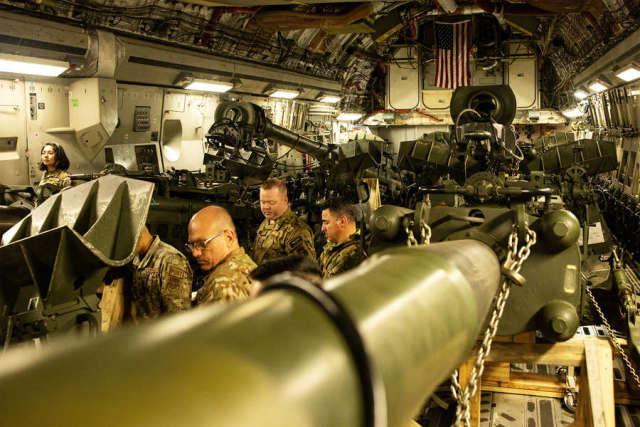SIPRI analysts told what weapons Russia and Ukraine bought before the conflict
Global military spending continues to grow, reaching a level of $2.1 trillion. This is stated in the report of SIPRI (Stockholm International Peace Research Institute, Stockholm International Peace Research Institute), a leading center for the study of military conflicts. A special place in the report is occupied by the analysis of military expenditures of Moscow and Kiev. Military observer of the Newspaper.En" Mikhail Khodarenok studied the Russian and Ukrainian sections of the document.
Russia has made a bet on missiles
Russia, according to SIPRI, increased its military spending by 2.9% in 2021 to $65.9 billion. This was the third year of growth in a row, and in 2021 Russia's military spending reached 4.1% of GDP.
"High revenues from oil and gas have helped Russia to increase its military spending. These costs decreased between 2016 and 2019. After that, they began to increase," said Lucy Bero-Sudro, director of the SIPRI military spending and arms production program.
The report emphasizes that Russia has recently paid great attention to the development of missile weapons and is actively using them during the conflict in Ukraine.
SIPRI analysts specify that over the past six years, the Armed Forces of the Russian Federation have received 17 coast Guard missile systems "Bal" and "Bastion". 12 missile regiments were re-equipped with the Yars complex, 10 missile brigades with the Iskander complex, and 20 anti-aircraft missile regiments were armed with the S-400 air defense system. The Dagger hypersonic complex has been adopted.
13 aviation regiments received upgraded generation 4++ aircraft (MiG-31BM, Su-35S, Su-30SM and Su-34), and three army aviation brigades and six helicopter regiments received Ka-52 and Mi-28 helicopters.
In the near future, we should expect the receipt of a number of more samples of military equipment for equipping the Armed Forces of the Russian Federation.
Also in the near future, the hypersonic anti-ship cruise missile "Zircon" (or 3M22) is being supplied to the Russian Navy. This product is planned to replace the heavy anti-ship missile P-700 "Granite".
Tests of the Tu-160M/M2, a multi-mode supersonic strategic missile carrier with variable wing geometry, begin. The strategic bomber will be equipped with fully updated avionics and engines. This missile carrier is designed for new long-range weapons. The Tu-160M/M2 will form the basis of aviation strategic nuclear forces for decades to come.
NATO weapons are being destroyed in the warehouses of the Armed Forces of Ukraine
SIPRI analysts note that Kiev's military spending has increased by 72% since the annexation of Crimea to Russia in 2014. In 2021, expenditures accounted for 3.2% of the country's GDP, reaching $5.9 billion.
"Despite the colossal increase in military spending, before the conflict, the United States and its partners were afraid to supply Ukraine with heavy weapons. Largely due to systemic corruption. There was no certainty that the weapons would not end up on the black market. Since the 1990s, Ukraine has gained a reputation as a country from which Soviet weapons were illegally supplied to the Middle East, Africa and Asian countries. The same fate could befall NATO equipment. Therefore, until the very beginning of hostilities, NATO countries offered Ukraine mostly auxiliary equipment like thermal imagers and light small arms," the American Defense News portal notes.
After the start of Russia's special military operation in Ukraine, the situation has changed.
On April 21, 2022, US President Joe Biden announced the allocation of a large package of military assistance to Ukraine in the amount of $ 800 million. This package followed just eight days after the previous one, also amounting to $800 million, and became the eighth portion of American military assistance since the beginning of the Russian special military operation in Ukraine on February 24. The total amount of US military aid officially allocated to Kiev under these packages now reaches $3.35 billion, and since March 2021 - $ 4 billion.
According to the US Department of Defense, the most important part of the new aid package is the transfer to Ukraine of 72 towed 155 mm howitzers, 72 tractors for them and 144 thousand artillery rounds from the presence of the US armed forces.
In addition, the military assistance package announced on April 21 included the delivery of 121 new Phoenix Ghost barrage ammunition complexes - as stated, specially developed by the US Air Force in accordance with the requirements of the Armed Forces of Ukraine in the shortest possible time.
SIPRI analysts conclude that against the background of the ongoing special military operation in Ukraine, the focus in Kiev's military spending in the near future will largely shift to the following areas: unmanned aircraft (reconnaissance vehicles, attack UAVs and barrage ammunition), artillery and multiple rocket launchers with a long firing range (artillery guns - at least 70-80 km, MLRS - at least 300 km), anti-tank missile systems and grenade launchers, air defense equipment.
At the same time, even a large volume of arms supplies does not guarantee Ukraine a reliable defense. A significant part of the weapons and military equipment delivered to the country were destroyed in warehouses or during transportation to the line of contact.
The opinion of the author may not coincide with the position of the editorial board.
Biography of the author:
Mikhail Mikhailovich Khodarenok is a military columnist for the newspaper.Ru", retired colonel.
He graduated from the Minsk Higher Engineering Anti-Aircraft Missile School (1976), the Military Air Defense Command Academy (1986).
Commander of the S-75 anti-aircraft missile division (1980-1983).
Deputy Commander of the anti-aircraft missile regiment (1986-1988).
Senior Officer of the General Staff of the Air Defense Forces (1988-1992).
Officer of the Main Operational Directorate of the General Staff (1992-2000).
Graduated from the Military Academy of the General Staff of the Armed Forces of Russia (1998).
Columnist of "Nezavisimaya Gazeta" (2000-2003), editor-in-chief of the newspaper "Military-Industrial Courier" (2010-2015).
Mikhail Khodarenok

